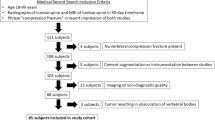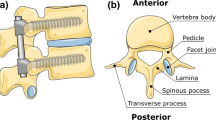Abstract
Purpose
The goals of this study were to assess the accuracy of pedicle screw insertion using an intraoperative cone beam computed tomography (CBCT) system, and to analyze the factors potentially influencing this accuracy.
Methods
Six hundred and ninety-five pedicle screws were inserted in 118 patients between October 2013 and March 2016. Screw insertion was performed using 2D-fluoroscopy or CBCT-based navigation. Accuracy was assessed in terms of breach and reposition. All the intraoperative CBCT scans, done after screw insertion, were reviewed to assess the accuracy of screw placement using two established classification systems: Gertzbein and Heary. Generalized linear mixed models were used to model the odds (95% CI) for a screw to lead to a breach according to the independent variables.
Results
The breach rate was 11.7% using the Gertzbein classification and 15.4% using the Heary classification. Seventeen screws (2.4%) were repositioned intraoperatively. The only factor affecting statistically the odds to have a breach was the indication of surgery. The patients with non-degenerative disease had a significantly higher risk of breach than those with degenerative disease.
Conclusion
Use of intraoperative CBCT as 2D-fluoroscopy or coupled with a navigation system for pedicle screw insertion is accurate in terms of breach occurrence and reposition. However, these rates depend on the classification or grading system used. Use of a navigation system does not decrease the risk of breach significantly. And the risk of breach is higher in non-degenerative conditions (trauma, scoliosis, infection, and malignancy disease) than in degenerative diseases.



Similar content being viewed by others
References
Boucher HH (1959) A method of spinal fusion. J Bone Jt Surg 41B(2):248–259
Boos N, Webb JK (1997) Pedicle screw fixation in spinal disorders: a European view. Eur Spine J 6(1):2–18
Donohue ML, Moquin RR, Singla A, Calancie B (2014) Is in vivo manual palpation for the thoracic pedicle screw instrumentation reliable? J Neurosurg Spine 20:492–496
Jutte PC, Castelein RM (2002) Complications of pedicle screws in lumbar and lumbosacral fusions in 105 consecutive primary operations. Eur Spine J 11(6):594–598
Li G, Lv G, Passias P et al (2010) Complications associated with thoracic pedicle screws in spinal deformity. Eur Spine J 19(9):1576–1584
Tian NF, Huang QS, Zhou P et al (2011) Pedicle screw insertion accuracy with different assisted methods: a systematic review and meta-analysis of comparative studies. Eur Spine J 20(6):846–859
Lonjon N, Chan-Seng E, Costalat V, Bonnafoux B, Vassal M, Boetto J (2015) Robot-assisted spine surgery: feasibility study through a prospective case-matched analysis. Eur Spine J. doi:10.1007/s00586-015-3758-8
Lamartina C, Cecchinato R, Fekete Z, Lipari A, Fiechter M, Berjano P (2015) Pedicle screw placement accuracy in thoracic and lumbar spinal surgery with a patient-matched targeting guide: a cadaveric study. Eur Spine J 24(Suppl 7):S937–S941
Richter PH, Yarboro S, Kraus M, Gebhard F (2015) One year orthopaedic trauma experience using an advanced interdisciplinary hybrid operating room. Injury 46(Suppl 4):S129–S134
Raftopoulos C, Waterkeyn F, Fomekong E, Duprez T (2012) Percutaneous pedicle screw implantation for refractory low back pain: from manual 2D to fully robotic intraoperative 2D/3D fluoroscopy. Adv Tech Stand Neurosurg 38:75–93
Gertzbein SD, Robbins SE (1990) Accuracy of pedicular screw placement in vivo. Spine (Phila Pa 1976) 15(1):11–14
Heary RF, Bono CM, Black M (2004) Thoracic pedicle screws: postoperative computerized tomography scanning assessment. J Neurosurg 100(4 Suppl Spine):325–331
Amato V, Giannachi L, Irace C, Corona C (2010) Accuracy of pedicle screw placement in the lumbosacral spine using conventional technique: computed tomography postoperative assessment in 102 consecutive patients. J Neurosurg Spine 12(3):306–313
Motiei-Langroudi R, Sadeghian H (2015) Assessment of pedicle screw placement accuracy in thoracolumbosacral spine using freehand technique aided by lateral fluoroscopy: results of postoperative computed tomography in 114 patients. Spine J 15(4):700–704
Kotani Y, Abumi K, Ito M, Takahata M, Sudo H, Ohshima S, Minami A (2007) Accuracy analysis of pedicle screw placement in posterior scoliosis surgery: comparison between conventional fluoroscopic and computer-assisted technique. Spine (Phila Pa 1976) 32(14):1543–1550
Ling JM, Dinesh SK, Pang BC et al (2013) Routine spinal navigation for thoracolumbar pedicle screw insertion using the O-arm three-dimensional imaging system improves placement accuracy. J Clin Neurosci 21(3):493–498
Scheufler KM, Franke J, Eckardt A, Dohmen H (2011) Accuracy of image-guided pedicle screw placement using intraoperative computed tomography-based navigation with automated referencing. Part II: thoracolumbar spine. Neurosurgery 69(6):1307–1316
Kantelhardt SR, Martinez R, Baerwinkel S, Burger R, Giese A, Rohde V (2011) Perioperative course and accuracy of screw positioning in conventional, open robotic-guided and percutaneous robotic-guided, pedicle screw placement. Eur Spine J 20(6):860–868
Puvanesarajah V, Liauw J, Lo S, Lina I, Witham T (2014) Technique and accuracy of thoracolumbar pedicle screw placement. World J Orthop 5(2):112–123
Parker S, McGirt M, Farber S et al (2011) Accuracy of free-hand pedicle screws in the thoracic and lumbar spine: analysis of 6816 consecutive screws. Neurosurgery 68(1):170–178
Santos ER, Ledonio CG, Castro CA, Truong WH, Sembrano JN (2012) The accuracy of intraoperative O-arm images for the assessment of pedicle screw position. Spine (Phila Pa 1976) 37(2):E119–E125
Belmont PJ Jr, Klemme WR, Dhawan A, Polly DW Jr (2011) In vivo accuracy of thoracic pedicle screws. Spine (Phila Pa 1976) 26(21):2340–2346
Kosmopoulos V, Schizas C (2007) Pedicle screw placement accuracy: a meta-analysis. Spine 32(3):E111–E120
Gelalis ID, Paschos NK, Pakos EE, Politis AN et al (2012) Accuracy of pedicle screw placement: a systematic review of prospective in vivo studies comparing free hand, fluoroscopy guidance and navigation techniques. Eur Spine J 21:247–255
Kaminski L, Cordemans V, Cartiaux O, Van Cauter M (2017) Radiation exposure to the patients in thoracic and lumbar spine fusion using a new intraoperative cone-beam computed tomography imaging technique: a preliminary study. Eur Spine J. doi:10.1007/s00586-017-4968-z
Cordemans V, Kaminski L, Banse X, Cartiaux O (2017) Accuracy of a new intraoperative cone beam CT imaging technique (Artis zeego II) compared to postoperative CT scan for assessment of pedicle screws placement and breaches detection. Eur Spine J. doi:10.1007/s00586-017-5139-y
Sclafani J, Regev G, Webb J, Garfin S, Kim C (2011) Use of quantitative pedicle screw accuracy system to assess new technology: initial studies on O-arm navigation and its effect on the learning curve of percutaneous pedicle screw insertion. SAS J 5:57–62. doi:10.1016/j.esas.2011.04.001
Kleck C, Cullilmore I, La Fleur M, Lindley E, Rentschler M, Burger E, Cain C, Patel V (2016) A new 3-dimensional method for measuring precision in surgical navigation and methods to optimize navigation accuracy. Eur Spine J 25(6):1764–1774. doi:10.1007/s00586-015-4235-0
van Dijk JD, van den Ende RP, Stramigioli S, Köchling M, Höss N (2015) Clinical pedicle screw accuracy and deviation from planning in robot-guided spine surgery. Spine 40(17):E986–E991
Acknowledgements
The authors would like to thank the Louvain Translation Center (Centre de traduction de Louvain, CTL, Louvain-La-Neuve, Belgique) and S. Boulet for their contribution. Funding was provided by Siemens Healthcare (DE) and Brussels Capital Region-Innoviris.
Author information
Authors and Affiliations
Corresponding author
Ethics declarations
Conflict of interest
The authors declare that they have no competing interests.
Rights and permissions
About this article
Cite this article
Cordemans, V., Kaminski, L., Banse, X. et al. Pedicle screw insertion accuracy in terms of breach and reposition using a new intraoperative cone beam computed tomography imaging technique and evaluation of the factors associated with these parameters of accuracy: a series of 695 screws. Eur Spine J 26, 2917–2926 (2017). https://doi.org/10.1007/s00586-017-5195-3
Received:
Revised:
Accepted:
Published:
Issue Date:
DOI: https://doi.org/10.1007/s00586-017-5195-3




